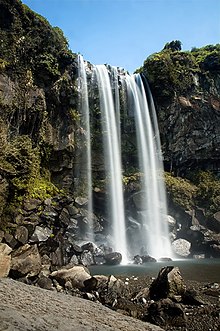

|
→top: Korean/Japanese reference formatting and minor fixes, removed: Official Site of Korea Tourism Org.:
|
citing claim
|
||
| Line 35: | Line 35: | ||
A legend states that Emperor [[Qin Shi Huang]] of China (259 BC – 210 BC) sent a servant, Seobul, to fetch the magical herbs of eternal youth from the island's mountain [[Hallasan]].<ref name=visitkorea>{{Cite web | title = Jeongbang Falls | url = http://www.visitkorea.or.kr/enu/SI/SI_EN_3_1_1_1.jsp?cid=264181 | accessdate = 7 June 2011 | archive-date = 11 March 2012 | archive-url = https://web.archive.org/web/20120311073911/http://www.visitkorea.or.kr/enu/SI/SI_EN_3_1_1_1.jsp?cid=264181 | url-status = live }}</ref><ref name="www.asiarooms.com"/> Though he failed to find the herb, he encountered Jeongbang Falls on the way and he left his [[autograph]], ''Seobul Gwaji'' (which literally means "Seobul was here"<ref name="www.jejuweekly.com">{{Cite web | title = Jeju Weekly | url = http://www.jejuweekly.com/news/articleView.html?idxno=369 | accessdate = 7 June 2011 | archive-date = 15 December 2011 | archive-url = https://web.archive.org/web/20111215090250/http://jejuweekly.com/news/articleView.html?idxno=369 | url-status = live }}</ref>), on the cliff wall, where it no longer remains.<ref name="www.asiarooms.com"/><ref name="english.tour2jeju.net">{{Cite web | title = ::Jeju Tour Info:: | url = http://english.tour2jeju.net/main/view.php?idno=50304&menu_id=12 | accessdate = 7 June 2011 | archive-date = 3 March 2016 | archive-url = https://web.archive.org/web/20160303220253/http://english.tour2jeju.net/main/view.php?idno=50304&menu_id=12 | url-status = live }}</ref> An inscription on the wall of the waterfall saying "Seobulgwacha", refers to Seobul's journey.<ref name=visitkorea/> The waterfall is one of the three famous waterfalls of Jeju, along with [[Cheonjiyeon Waterfall]] and [[Cheonjeyeon Waterfall]].<ref name="www.asiarooms.com"/> A smaller waterfall, [[Sojeongbang Waterfall]] is 300 m to the east.<ref name=Frommer/><ref name=visitkorea/><ref name="www.asiarooms.com"/> |
A legend states that Emperor [[Qin Shi Huang]] of China (259 BC – 210 BC) sent a servant, Seobul, to fetch the magical herbs of eternal youth from the island's mountain [[Hallasan]].<ref name=visitkorea>{{Cite web | title = Jeongbang Falls | url = http://www.visitkorea.or.kr/enu/SI/SI_EN_3_1_1_1.jsp?cid=264181 | accessdate = 7 June 2011 | archive-date = 11 March 2012 | archive-url = https://web.archive.org/web/20120311073911/http://www.visitkorea.or.kr/enu/SI/SI_EN_3_1_1_1.jsp?cid=264181 | url-status = live }}</ref><ref name="www.asiarooms.com"/> Though he failed to find the herb, he encountered Jeongbang Falls on the way and he left his [[autograph]], ''Seobul Gwaji'' (which literally means "Seobul was here"<ref name="www.jejuweekly.com">{{Cite web | title = Jeju Weekly | url = http://www.jejuweekly.com/news/articleView.html?idxno=369 | accessdate = 7 June 2011 | archive-date = 15 December 2011 | archive-url = https://web.archive.org/web/20111215090250/http://jejuweekly.com/news/articleView.html?idxno=369 | url-status = live }}</ref>), on the cliff wall, where it no longer remains.<ref name="www.asiarooms.com"/><ref name="english.tour2jeju.net">{{Cite web | title = ::Jeju Tour Info:: | url = http://english.tour2jeju.net/main/view.php?idno=50304&menu_id=12 | accessdate = 7 June 2011 | archive-date = 3 March 2016 | archive-url = https://web.archive.org/web/20160303220253/http://english.tour2jeju.net/main/view.php?idno=50304&menu_id=12 | url-status = live }}</ref> An inscription on the wall of the waterfall saying "Seobulgwacha", refers to Seobul's journey.<ref name=visitkorea/> The waterfall is one of the three famous waterfalls of Jeju, along with [[Cheonjiyeon Waterfall]] and [[Cheonjeyeon Waterfall]].<ref name="www.asiarooms.com"/> A smaller waterfall, [[Sojeongbang Waterfall]] is 300 m to the east.<ref name=Frommer/><ref name=visitkorea/><ref name="www.asiarooms.com"/> |
||
The waterfall is also known to be a location related to the [[Jeju uprising]] |
The waterfall is also known to be a location related to the 1948 [[Jeju uprising]]. Civilians caught up in the uprising were executed near the falls, and their bodies were disposed of over the waterfall.<ref>{{Cite web |last=박 |first=미라 |date=2023-05-29 |title=제주 유명관광지 ‘정방폭포’에 숨어있는 슬픈 4·3 이야기 |url=https://www.khan.co.kr/local/Jeju/article/202305291530001 |access-date=2024-06-19 |website=[[Kyunghyang Shinmun]] |language=ko}}</ref> |
||
==References== |
==References== |
||
| Jeongbang Waterfall | |
|---|---|

Along-exposure image of the waterfall (2007)
| |
 | |
| Location | Seogwipo, Jeju Province, South Korea |
| Coordinates | 33°14′41″N 126°34′18″E / 33.244649°N 126.571662°E / 33.244649; 126.571662 |
| Total height | 23 m (75 ft) |
| Number of drops | 1 |
| Total width | 8 m (26 ft) |
| Jeongbang Waterfall | |
| Hangul | 정방폭포 |
|---|---|
| Hanja | 正房瀑布 |
| Revised Romanization | Jeongbang Pokpo |
| McCune–Reischauer | Chŏngbang Pokpo |
Jeongbang Waterfall (Korean: 정방폭포) is a waterfall and popular tourist attraction located in Seogwipo, Jeju Province, South Korea.[1][2] The waterfall is 23 m (75 ft) high and is very close to the ocean.[2][3] Depending on the level of recent rainfall, it can be up 8 m (26 ft) wide.[4] The source of the waterfall is the stream Donghong-cheon.[5] It is considered to be one of Yeongjusipgeong, the ten greatest scenic wonders of Jeju Island.[1]
Legend states that a holy dragon lived underneath it.[6] It was said that the dragon's spirit is contained in the water which can cure diseases and bring rain during drought.[6] Furthermore, a nearby small waterfall is said to resemble a servant waiting on a lord.[6]
A legend states that Emperor Qin Shi Huang of China (259 BC – 210 BC) sent a servant, Seobul, to fetch the magical herbs of eternal youth from the island's mountain Hallasan.[7][1] Though he failed to find the herb, he encountered Jeongbang Falls on the way and he left his autograph, Seobul Gwaji (which literally means "Seobul was here"[8]), on the cliff wall, where it no longer remains.[1][9] An inscription on the wall of the waterfall saying "Seobulgwacha", refers to Seobul's journey.[7] The waterfall is one of the three famous waterfalls of Jeju, along with Cheonjiyeon Waterfall and Cheonjeyeon Waterfall.[1] A smaller waterfall, Sojeongbang Waterfall is 300 m to the east.[2][7][1]
The waterfall is also known to be a location related to the 1948 Jeju uprising. Civilians caught up in the uprising were executed near the falls, and their bodies were disposed of over the waterfall.[10]